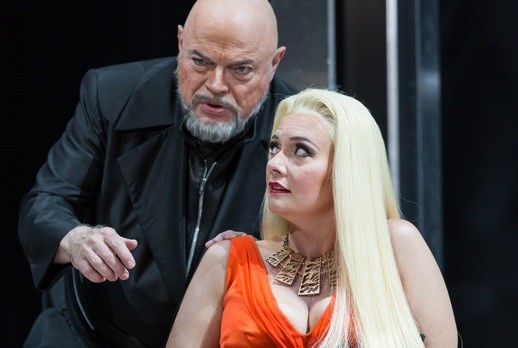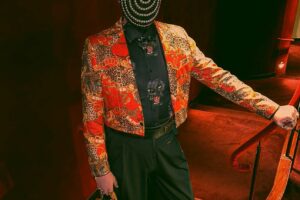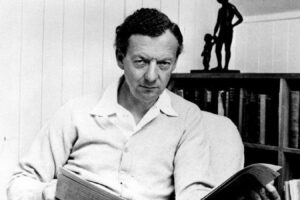

Many operagoers (myself included), approached this project with some trepidation, still harboring memories of the production’s half-baked partial run from the mid 2000s. Happily, these misgivings were largely swept aside by Francesca Zambello’s vastly improved and emotionally consuming vision, as well as the exceptional musical quality of the three cycles, presided over by music director Philippe Auguin.
All that said, the Götterdämmerung seen Sunday, while successful in many respects, is probably the least consistent installment of the cycle. The biggest issue again is the heavy handed environmental material that sometimes rankles in the Siegfried production, but often makes sense in the context of that opera’s ubiquitous nature imagery.
In Götterdämmerung, one can’t escape the fact that the environmental degradation metaphor is just too reductive to pair with the ambiguous nature of “evil” in the Ring. Images of polluting smokestacks and denuded landscapes play over the scene transition projections, turning every foreboding chord into some kind of environmental cautionary tale, a pedantic tic that grows tiresome quickly.
Moreover, the environmental tragedy theme distracts from the Ring’s wide-ranging meditation on the price of greed and self-interest. As this production’s Rheingold so memorably illustrates, Wagner is interested in the play of self-interest and power and how they damage human relationships and communities, not the inanimate environment.
But it’s easy to look past this misstep and appreciate this Ring for what it does well: genuinely compelling insights and sensitive direction, which, for the most part, work with the libretto and the music rather than against them, deriving conclusions that feel true to the work and enhancing its impact.
Consider this production’s trashy-wealthy Gibichungs, garbage people lazing around their sleek loft, narrowly focused on a need for external validation at the expense of all else. It’s an easy conceit, but the direction spins it into a thoroughly entertaining scene that effectively establishes the corrosive human pettiness that will now guide the opera’s endgame. Indeed, the great tragedy of Siegfried’s undoing is that the hero is unable to last five minutes in the world of men before he is embroiled in some Gibichung dating nonsense.
Later In Act II, we see a broader Gibichung community that mirrors the principals’ warped values assembled in the show’s most impressive set piece, a vast and intimidating chrome and glass lobby (sets are by Michael Yeargan). Here Hagen presides over a sort of post-apocalyptic fascist militia outfit that enforces a rigid gender hierarchy over their futuristic concubines, a nice use of the mute women’s chorus. As Brünnhilde lashes out at Siegfried and Gunther, the men impose a preemptive group punishment on the militia wives lest they get ideas.

This unsentimental characterization of Siegfried yields some interesting ideas, though there are dramatic tradeoffs in moments like the Dawn Duet. Not the most convincing love scene to begin with, this Brünnhilde might as well be realizing she made a huge mistake last night and needs to get this hot dumb guy out of her apartment stat (”Oh there are no cabs around? Just borrow my horse, I insist…”). Siegfried’s harrowing death scene looks different in this light too. Staged with painfully realistic agony and lurid lighting effects (by Mark McCullough), the scene evokes a sense bitter futility but misses the touch of human compassion often so affecting here.
A lot is wrapped up in the finale of this Götterdämmerung, which begins with elegant minimalism: as Brunhilde enters for the last time the stage is entirely cleared of set pieces and the next ten minutes play out as quiet Greek drama on an empty stage. Things proceed to get more complicated from there with a wide-ranging mix of ideas for the final stretch of the show, only some of which work.
Much has been made of the “feminist” aspects of the finale, which leaves the remaining women—Brunnhilde, the Rhinemaidens, a redeemed Gutrune, and the militia wives—to construct the funeral pyre and cleanse the world. If some of this is a bit groan inducing (the women literally “taking out the trash” from the Rhinemaidens’ gully to build the pyre, rom-com denouement hugs all around for the Rhinemaidens) the general idea rings true, given how deeply this production has invested in the themes of sex and power that run through the text.
More controversial is the choice to deny Hagen his death in the overflowing banks of the Rhine. Instead, the militia wives shuffle him downstage, place a bag over his head and dispense some revolutionary justice. Still clad in bright orange hunting gear from earlier in the Act, the image echoes War on Terror detainee photos, an unsettling, off-color note to inject at this point in the proceedings.
As Valhalla starts to burn we get another clunker—computer projections of those square photos of the helden from Walkure raining down like big dumb snowflakes, a gimmick that is both ridiculously literal and exceptionally unattractive. Thankfully this is over quickly though, and we see a lovely extended image of the Rhinemaidens playing with the returned Rhinegold in a rain of blue ash.
The now famous (perhaps infamous) final gesture in the show, choreographed to the strains of that heartrending last motif, is a small child in a simple white shift carrying a sapling, which she plants downstage as the background melts into a brilliant blue sky. My rational brain really dislikes how this bit reinforces the most facile version of the “environmental” Ring and turns an ambiguous ending into a hallmark card about new beginnings, but I have to give Zambello and her maudlin wizardry some credit here—this bit reliably broke me each time I saw it.
This run has been favored with a true embarrassment of Brunnhildean riches, between Christine Goerke’s irresistible surprise turn in the first Walkure, Catherine Foster’s brilliant vocalism for the balance of Cycle I and Cycle II, and here in the final Cycle, a focused and magnetic interpretation from Nina Stemme.
After Foster’s lovely sounding but somewhat casual Brunnhilde in Cycle II, Stemme offered something else entirely, leaning into the music and never allowing the drama to fall below a quiet smolder. Even more staid passages, like the “Ruhe” section of the Immolation scene, sometimes merely a rest stop on the way to the main event, were spellbinding here, a marvel of sustained tension and intricate shading.
She carried that sensibility into Götterdämmerung’s more spectacular sequences as well. While Stemme delivers a consistently rounded and beautiful tone in the opera’s more demanding music, she doesn’t fire off high notes with the ease that some prize in this role. Instead, there is a weight and fullness to her voice that makes it all the more exciting in the stratosphere, an earthbound instrument driven to incredible lengths. Her frenzy in Act II was perhaps the most exhilarating sustained feat of singing of the evening, a deftly shaped, relentless barrage of full-throated rage.
Daniel Brenna’s Götterdämmerung Siegfried wasn’t quite as successful as his Siegfried Siegfried. That untiring, dark knot of a voice still wows with its ability to soar over a roiling pit, but the lack of finesse is more of an issue in the gentler confines of the final evening. Rough-hewn dynamics approximated the passionate ebb and flow of the Dawn Duet, while the delicate vocal effects that can soften Siegfried’s death scene never really materialized.
The Gibichungs each made a strong musical and dramatic contribution. The enveloping, deep midnight color of Eric Halfvarson’s bass fueled an obnoxious but thoughtful Hagen, delighted to be running circles around his various pawns and opponents in the quest for the Ring. Though I was ambivalent about Ryan McKinny’s Donner in Das Rheingold, here he showed off an expressive, musical baritone, and clearly delineated Gunther’s transition from proud, spineless cad to a man consumed by self-loathing and in far over his head. Melissa Citro’s Gutrune, presented here as a sort of ditzy Donatella Versace, kept the Gibichung farce moving with keen comic timing, while offering an uncommonly luxurious sound in this part.
Jamie Barton’s rich, vibrant mezzo made for an exceptional Waltraute. Sporting a very cute bob (Valkyrie salons know manageable hair), she excelled in a sensitive monologue about Wotan’s dilemma and a subsequent explosive encounter with Stemme. Gordon Hawkins returned with his powerful Alberich for a particularly intimate staging of his Act II scene with Hagen that emphasized the familiarity, if not exactly tenderness, of this father-son relationship.
Götterdämmerung’s two trios offered a final opportunity to appreciate the depth of casting that has been a trademark of this Ring. The Norns offered vocal glamour in both solo voices and aggregate sound–besides another welcome opportunity to hear Barton as Third Norn, Marcy Stonikas lent her expressive soprano to the Second Norn, while Lindsay Ammann’s thrilling contralto sound popped up again as First Norn (with distinctive turns as Erda as well as Schwertleite, Ammann has secured most valuable utility player status for this run). The Rhinemaidens (Jacqueline Echols, Catherine Martin and Renee Tatum), now reduced to a trash-filled Rhine in the absence of their precious, reprised the shimmering sound that distinguished their Rheingold appearance.
After an exuberant if sometimes bruising Siegfried, Philippe Auguin and the WNO Orchestra delivered a dramatically attentive and transparent Götterdämmerung, playing sensitive accompanist in passages like the Waltraute scene and the ramp up to the Immolation, while consistently allowing the complex orchestral texture to shine through. Big showpieces unfolded with careful attention to detail and the occasional moment of overwhelming terror–such as the cataclysmic music when Siegfried appears disguised as Gunther, or the violent chords of the funeral march. Breakneck speeds in the Act II chorus (trans. “Go Hagen, Get the Ring Back!”), and a thrilling performance from the men of the WNO chorus, turned this occasionally bloated sequence into a lusty, menacing ride.
If calling this production an “American” Ring still seems a bit too cute, it may be fitting in a different sense—here is a Ring that makes use of a broad palette of contemporary reference and allusion, not in the service of revolutionary analysis or critique (not that there’s anything wrong with that), but as a way to provoke engagement with the work’s sprawling world of ideas about class, gender, capitalism, and so on, as well as its emotional core.
Indeed, one might suggest that this audience-friendly Ring is a bit of an indictment of something like the brainless LePage Ring, which doubled down on the idea that a high mythology Ring is still the appropriate alternative to the dread European stagings with their nefarious motives.
Putting aside the excesses of the environmental bits, Zambello clearly has little interest in undermining the emotional and dramatic thrust of the Ring. Yet this staging still finds simple ways to access the rich web of social and philosophical significance that make the Ring such a fascinating work beyond its gorgeous music. In a worthwhile production like this one, all those messy ideas should be treated as a feature, not a bug.
Photo: Scott Suchman


























Comments